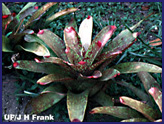

A few hundred species of animals and plants are known to science to depend to a greater or lesser extent on bromeliads as a place in which to live, or as food. These few hundred species probably are a small fraction of those that exist, because these animals and plants, together called the bromeliad biota (the word biota means all living organisms, regardless of whether they are animals, plants, fungi, bacteria, or viruses), are yet poorly studied by biologists and there is an enormous amount of research left to do. It would not be surprising if there are more species of these organisms than there are of bromeliads.
Some of the animal species among this biota, and by animal is meant invertebrate as well as vertebrate animals, depend totally upon bromeliads. Without access to bromeliads, the specialist animals among them could not exist. When a population of a bromeliad species in nature becomes rare, endangered, or extinct, the specialist animals likewise must become endangered or extinct. Even though some extremely rare bromeliad species are now maintained in culture by bromeliad enthusiasts, little or no thought has been given to maintenance of the animal species that depend upon them. Loss of a bromeliad species on the coast of Brazil or in the mountains of Ecuador, even if the bromeliad is maintained in culture in botanical gardens or private collections, may cause extinction of species of frogs, insects, and other animals.
A few species of the animals, especially of the insects among them, do substantial damage to cultivated bromeliads. In their homelands, the animals that eat the bromeliads in nature are themselves held in check by other things (diseases and other animals) that eat them. In cultivation in countries other than their homelands, the bromeliads may be subject to devastating attack by such animals; this suggests that the animals (we call them pests when they harm plants that we want) are not under control by their own natural enemies, which have been left behind in their homelands.
This and the following pages on Bromeliad Biota are maintained by Howard Frank jhfrank@ufl.edu at the Entomology and Nematology Department, University of Florida, Gainesville, FL 32611-0630, USA, with assistance from friends and colleagues. Our intent is that these pages should provide information to anyone who wants to learn, whether professional biologist (acarologist, algologist, bacteriologist, botanist, ecologist, entomologist, herpetologist, invertebrate biologist, mammalogist, mycologist, nematologist, or ornithologist), or bromeliad grower, or schoolboy/girl wanting to undertake a school project, or newspaper or magazine reporter.